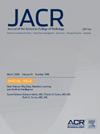数字乳房x线照相术与数字乳腺断层合成术异常筛查的诊断管理途径。
IF 5.1
3区 医学
Q1 RADIOLOGY, NUCLEAR MEDICINE & MEDICAL IMAGING
引用次数: 0
摘要
目的:为了评估从数字化乳房x线摄影(DM)到数字化乳房断层合成(DBT)筛查的转变,我们比较了异常筛查DBT和DBT的诊断检查类型和频率、检查途径以及解决时间。方法:本队列研究包括2011-2020年在6个乳腺癌监测联盟登记处的107家机构进行的异常结果的筛查检查。诊断检查包括诊断性糖尿病、诊断性DBT、超声、磁共振成像以及异常筛查后90天内的活检。我们使用比例和95%置信区间(95% ci)的差异来比较检查方式和检查程序的数量。用log-rank检验比较DBT和DM的诊断解决时间。结果:在77,123例异常DBT和197,589例异常DM筛查中,诊断路径上的成像方式数量相似。与DM异常患者相比,DBT异常患者的第一次检查更多的是超声检查(21.1%对4.7%)。DBT的活检率高于DM (16.2% vs. 14.0%,比例差异=2.27 95%CI:1.97-2.58), DM后的活检率高于DBT后的活检,手术比FNA/core更有可能(5.8% vs.3.2%,比例差异=2.6,95%CI:2.19-3.01),导致每1000个异常筛查中,DBT的切除活检率为5.1,DM为8.0。诊断时间相似(中位数=10天)。结论:我们发现异常筛查DBT与DM后诊断途径的类型存在差异。虽然异常DBT后活检率更高,但异常DM筛查后活检类型可能更具侵入性(手术切除)。本文章由计算机程序翻译,如有差异,请以英文原文为准。
Diagnostic Management Pathways for Workup of Abnormal Screening With Digital Mammography Versus Digital Breast Tomosynthesis
Purpose
Our objective was to assess the transition from digital mammography (DM) to digital breast tomosynthesis (DBT) screening, the authors compared diagnostic workup type and frequency, workup pathways, and time to resolution of abnormal screening between DBT and DM.
Methods
This cohort study included screening examinations with an abnormal results from 2011 to 2020 at 107 facilities across six Breast Cancer Surveillance Consortium registries. Diagnostic workup included diagnostic DM, diagnostic DBT, ultrasound, MRI, and biopsy within 90 days of the abnormal result on screening mammography. Workup modalities and number of workup procedures were compared using differences in proportion and 95% confidence intervals (CIs). Time to diagnostic resolution between DBT and DM was compared using a log-rank test.
Results
Among 77,123 DBT and 197,589 abnormal DM screening examinations with abnormal results, the number of imaging modalities in the diagnostic pathway was similar. The first workup procedure was more often ultrasound after abnormal results on DBT compared with DM (21.1% versus 4.7%). Biopsy rates were higher for DBT versus DM (16.2% versus 14.0%; difference in proportions = 2.27; 95% CI, 1.97-2.58) with biopsies after DM versus DBT more likely surgical versus fine-needle aspiration or core (5.8% versus 3.2%; difference in proportions = 2.6; 95% CI, 2.19-3.01), resulting in a rate of excision biopsy per 1,000 screens with abnormal findings of 5.1 for DBT and 8.0 for DM. Time to diagnostic resolution was similar (median, 10 days).
Conclusions
This study revealed differences in the type of diagnostic workup pathways after abnormal results on screening DBT versus DM. Although the biopsy rate was higher after abnormal results on DBT, the biopsy type may be more invasive (surgical excision) after abnormal results on DM.
求助全文
通过发布文献求助,成功后即可免费获取论文全文。
去求助
来源期刊

Journal of the American College of Radiology
RADIOLOGY, NUCLEAR MEDICINE & MEDICAL IMAGING-
CiteScore
6.30
自引率
8.90%
发文量
312
审稿时长
34 days
期刊介绍:
The official journal of the American College of Radiology, JACR informs its readers of timely, pertinent, and important topics affecting the practice of diagnostic radiologists, interventional radiologists, medical physicists, and radiation oncologists. In so doing, JACR improves their practices and helps optimize their role in the health care system. By providing a forum for informative, well-written articles on health policy, clinical practice, practice management, data science, and education, JACR engages readers in a dialogue that ultimately benefits patient care.
 求助内容:
求助内容: 应助结果提醒方式:
应助结果提醒方式:


